28.02.19
Two New Visitor Centres, Many Whiskies (New & Old)
First off, after the plans launched last month for the new Port Ellen and Rosebank distilleries, we have new visitor centre for Bunnahabhain Distillery on Islay and proposed Johnnie Walker experience in Edinburgh.
The proposed Johnnie Walker site, with joint plans submitted to the city Council by Diageo and the building’s owners, is a former landmark department store on  Edinburgh’s Princes Street. It’s just across from the 5-star Caledonian Hotel and Diageo intends it to be every bit as successful as their Guinness Storehouse in Dublin. The various floors would include interactive multi-sensory rooms, each one showcasing the characteristics of four key single malts in the JW blends. Those are Cardhu, Caol Ila, Clynelish and Glenkinchie. Indeed, all 12 of Diageo’s distillery visitor facilities will get an upgrade as part of a £185 million spend and the four above-mentioned distilleries will each get a Johnnie Walker room.
Edinburgh’s Princes Street. It’s just across from the 5-star Caledonian Hotel and Diageo intends it to be every bit as successful as their Guinness Storehouse in Dublin. The various floors would include interactive multi-sensory rooms, each one showcasing the characteristics of four key single malts in the JW blends. Those are Cardhu, Caol Ila, Clynelish and Glenkinchie. Indeed, all 12 of Diageo’s distillery visitor facilities will get an upgrade as part of a £185 million spend and the four above-mentioned distilleries will each get a Johnnie Walker room.
Edinburgh’s Johnnie Walker home will also feature a history of the brand and company which will celebrate its 200th birthday in 2020 and look at the work of whisky blenders. I can only applaud any emphasis given to the art and craft of blending to remind people that whisky isn’t all about single malts. The sensory rooms will help people learn about whisky making through touch, taste and smell. I rather think some distillery sounds might be nice too, if they can, as every distillery has it’s process noises. Lastly, there is an onsite bar with drams and tastings though the final format of the latter is not elaborated on as yet. The bar will be high up, given the venue’s location and great views over the city centre. No mention of a restaurant but you don’t want food smells getting in the way of whisky nosing – well, I certainly wouldn’t.
 Recently begun are Distell’s works, announced in 2017, at its Bunnahabhain Distillery on Islay. I’m glad that one owner of this distillery is finally seeing sense in investing there and they want to make it into a “world-class whisky destination”. Lovely location, fabulous whisky, great people – but not the loveliest distillery to look at and nothing by way of facilities except the shop, till now. To be honest, even some coats of white paint would have made it look much less grim from the outside but this goes far beyond that. The refurbishment, reconfiguration and expansion programme will cost £10.5 million and take three years.
Recently begun are Distell’s works, announced in 2017, at its Bunnahabhain Distillery on Islay. I’m glad that one owner of this distillery is finally seeing sense in investing there and they want to make it into a “world-class whisky destination”. Lovely location, fabulous whisky, great people – but not the loveliest distillery to look at and nothing by way of facilities except the shop, till now. To be honest, even some coats of white paint would have made it look much less grim from the outside but this goes far beyond that. The refurbishment, reconfiguration and expansion programme will cost £10.5 million and take three years.
The works cover a new visitor centre with cafe and retail area promising beautiful views over the bay; a new filling store with improvements to the pump house and production areas; upgrades for the six onsite cottages to be used as holiday accommodation (these were looking terribly tired last time I saw them). Presumably, a new parking area will feature as it’s been rather tight up till now. Derek Scott, brand director for malts at Distell, said: “Our investment programme here at Bunnahabhain is about improving the operational side of our distillery for the long-term future.
“We are restoring our buildings to their former glory and providing a visitor experience where we don’t just welcome visitors – after the long, winding journey to get here, we help them enjoy a piece of Bunnahabhain life. The plan’s aim is to make the navigation of the site much easier for the visitor and to, in simple terms, declutter it. This will ensure the buildings are more efficient from a storage point of view and located in better-suited, more accessible locations to the production buildings.” Some warehousing has already been taken down to make way for the new visitor centre but whisky will continue to be matured onsite during and after the works. Also, there is a commitment to recycle 99% of the materials from demolition with the bulk of them being re-used at the site. There’s not mention of it but I find myself wondering if there will be any upgrade of the single track road leading up to the distillery and leaving in place the cask end sign which points to Bunnahabhain and, in the other direction, “Other Places”. I think part of the charm of getting there is the single track road with passing places. You feel you’re away from the rest of the world, though with Ardnahoe just off that road before you get to Bunna there’s a case for road improvement with all the certain increase in traffic. Maybe it’s already happened as I haven’t been over since last year’s Feis Ile. Anyway, I really look forward to seeing the finished article and hope it all goes well for them.
This month’s tasting notes are for Kingsbarns Dream to Dram from Wemyss Malts, Glengoyne Legacy Series Chapter 1 and The Arran Malt 21 Year Old.
Let’s look at Kingsbarns Dream to Dram (46% abv; about £44.95 per bottle) first. This became available at the end of January but the tasting sample wasn’t here on time 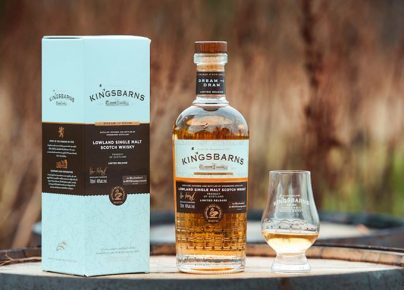 for that column, though the launch was featured. It’s their first flagship expression from a distillery opened late 2014 with the first spirit going into cask in March 2015. The name comes from the Wemyss family’s long held wish to bring distilling to Fife (to complement their successful blending and bottling of others’ whiskies) and it’s been done with local barley from East Fife. Now the media release says the East Neuk of Fife enjoys high levels of sunshine. As a Fifer myself, I’d say that was relative but they do grow good barley there. Maturation is primarily in high quality first fill bourbon casks (90%), sourced exclusively from Heaven Hill in Kentucky, with the remainder maturing in shaved, toasted and re-charred wine casks. All Kingsbarns casks are matured in warehouses not far from the distillery in Fife.
for that column, though the launch was featured. It’s their first flagship expression from a distillery opened late 2014 with the first spirit going into cask in March 2015. The name comes from the Wemyss family’s long held wish to bring distilling to Fife (to complement their successful blending and bottling of others’ whiskies) and it’s been done with local barley from East Fife. Now the media release says the East Neuk of Fife enjoys high levels of sunshine. As a Fifer myself, I’d say that was relative but they do grow good barley there. Maturation is primarily in high quality first fill bourbon casks (90%), sourced exclusively from Heaven Hill in Kentucky, with the remainder maturing in shaved, toasted and re-charred wine casks. All Kingsbarns casks are matured in warehouses not far from the distillery in Fife.
The packaging reflects the doocot (dovecot) on the old farm site which dates from the 1800’s and features a pigeon on the label. Indeed, the tasting sample arrived in a little box tied with a pale blue velvet ribbon and pigeon charm attached which I did think was a dove.
Appearance: Pale-medium gold; barley straw. Some brass glints. Tears form fairly swiftly and run close.
Nose: Light, fresh and floral then delightful fruit notes – stone and dried; dab of marzipan; some wax polish; green notes too; pear juice. Cooked cereals, lightly malty. Touch of oak and vanilla from the bourbon wood. Develops more vanilla custard notes as it sits and maybe a little white chocolate and creamy, soft caramels. With water there is a little more pear, wax and light oak. It seems to go flatter on the nose briefly then brightens up again with more fruit notes.
Palate: light malt moving into rich, cooked barley; zesty/sherbety on the tongue; pears dominate; a touch bitter at the sides afterwards and salt notes too (it’s not far from the coast); some oak tannins and a candy sweetness (like the old Dolly Mixture sweets)
Finish: Quite long for such a young whisky; lively; spritzy/zesty with oak and fruit and a touch of salt still.
Seriously, this is a triumph and I’m so looking forward to trying older expressions as they develop. When Kingsbarns first opened I was fortunate enough to taste the new spirit and remember it being a delightful new spirit, complex even then. I deliberately did not look at my notes from then till after I had tasted this to see what remained from the few years of maturation. I was pleased to see how much was still there and how well it had developed.
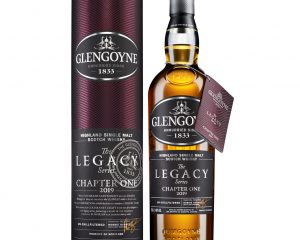 Glengoyne Legacy Series Chapter One (48% abv; no added colour; no chill-filtration) is only one of the latest from Glengoyne as a new very limited edition 30 Year Old has also come out just recently (no sample of that one as it’s £700/bottle). This is the first new, global release in nearly two years and was created and bottled to celebrate the legacy of 19th century manager, Cochrane Cartwright, who slowed down the distillation to get maximum fruit and sweetness from the spirit but also introduced sherry casks for maturation to the distillery.
Glengoyne Legacy Series Chapter One (48% abv; no added colour; no chill-filtration) is only one of the latest from Glengoyne as a new very limited edition 30 Year Old has also come out just recently (no sample of that one as it’s £700/bottle). This is the first new, global release in nearly two years and was created and bottled to celebrate the legacy of 19th century manager, Cochrane Cartwright, who slowed down the distillation to get maximum fruit and sweetness from the spirit but also introduced sherry casks for maturation to the distillery.
Appearance: Rich amber gold with old gold highlights. Tears form a solid edge at first but then speed up and run fairly closely. Second wave slower and wider.
Nose: Slightly damp warehouse oak at first; dried fruit – sultanas and golden raisins; baked pears; some vanilla and a light hint of sulphur; toffees; a touch of oil of claryssage. Leave a while and more rich dried fruit comes through.
With water, it’s softer with more pear notes; creamier vanilla; orange zest which fades quickly then dried light fruits – apricots and sultanas.
Palate: A slightly unctuous mouthfeel; tastes slightly waxy; some oak but soft tannins; vanilla and some sweet and savoury spices. Not as varied and rich for me on the palate as it is on the nose.
Finish: Long; somewhat waxy with oak vanilla and some spice warmth.
This one is available at a price of around £54.99 per bottle dependent on country.
The Arran Malt 21 Year Old Limited Release (46% abv) is the last tasting note for this month. It’s been around since December but the sample came in end of January and a bottle will retail at around £115.

Appearance: Rich, almost old gold colour with definite brass highlights and an amber tinge in the middle. Tears slow to form and quite clingy at first.
Nose: Quite green and leafy at the start; waft of vanilla and light oak notes; then waxy and more fruit- sultana and a hint of grapefruit; a bit of varnish and earthen floor dampness; touch of citrus oil. With water, more oak vanilla and bit more fruit and earthiness. Some sweet cake spices.
Palate: Quite mouth drying and surprisingly astringent; herbs and spices plus a floral palate; hint of pineapple juice and a bit of soft toffee. Some oak and quite lively on the tongue. Lighter than expected for a 21 year old.
Finish: Longish with pineapple fruit but herbal and dry too. The zestiness on the tongue remains.

So what else has been happening? Well, Compass Box have released a very limited expression called Tobias & The Angel. No sample but look out for it. It’s at 47.6% abv and will retail from around £450 /70cl. bottle with only 2,634 bottles available globally. It is available from 1st March and follows on from their Eleuthera blend from 2002. The blended malt is made up of 50.9% Clynelish whisky matured for 24 years in US oak hogsheads and 49.1% Caol Ila matured for rather longer in the same cask type. Compass Box whiskies are always worth seeking out and this is an intriguing combination.

In April, Port Ellen will release the first in an “Untold Stories” series worldwide. It’s called The Spirit Safe at 39 years old and one of the oldest ever from the distillery which was closed in 1983 but is being brought back to life in a new project to be completed in 2021. There will be only 1500 bottles with very special packaging – “exquisite details from the spirit safe’s traditional craftsmanship have been woven into the design of the release. Only the holders of two unique keys can unlock the precious single malt from its box. The first key unlocks the wrapping, the second key opens the window to the bottle, beautifully telling a story of innovative spirit and industry standard setting.” You’ll need to break into those piggy banks as it will cost around £4,500 /70cl bottle. Available globally early April from luxury retailers only.
Master Blender and Distiller, Richard Paterson has collaborated with Massimo Bottura, chef proprietor of one of the world’s best restaurants to create The Dalmore 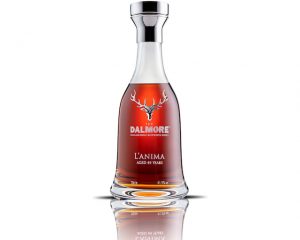 L’Anima (49 years old). It will feature in an online sale at Sotheby’s from 25 April – 9 May with proceeds going to Bottura’s Food for the Soul organisation which empowers communities to combat food waste through social inclusion. A worthy cause. It’s at 41.5% abv in a crystal decanter with silver collar and silver stag stopper. The outer packaging is a handcrafted cabinet of Italian olive wood, American black walnut and solid ebony by talented Scottish craftsman John Galvin. The buyer will also enjoy a dinner at Bottura’s Osteria Francescana in Modena, a city also home to some of the Ferrari facilities as well as at nearby Maranello. Quite appropriate really. Fine old whisky, world class cuisine and fine engineering in exquisite cars.
L’Anima (49 years old). It will feature in an online sale at Sotheby’s from 25 April – 9 May with proceeds going to Bottura’s Food for the Soul organisation which empowers communities to combat food waste through social inclusion. A worthy cause. It’s at 41.5% abv in a crystal decanter with silver collar and silver stag stopper. The outer packaging is a handcrafted cabinet of Italian olive wood, American black walnut and solid ebony by talented Scottish craftsman John Galvin. The buyer will also enjoy a dinner at Bottura’s Osteria Francescana in Modena, a city also home to some of the Ferrari facilities as well as at nearby Maranello. Quite appropriate really. Fine old whisky, world class cuisine and fine engineering in exquisite cars.
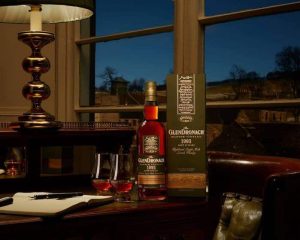
The Glendronach has a new expression in The Glendronach 1993 Masters 25 Year Old, taken from PX and Oloroso sherry casks by Master Blender, Rachel Barrie. It’s at 48.2% abv and is in non-US specialists round the world now and in the USA from October. Don’t know why the delay. I’d say let’s hope there’s some left for them to have but with the company under American ownership then they’ll make sure there is. This one won’t be cheap either but will doubtless be so worth it. One of those luscious whiskies that makes you want roll around in it to feel it on your skin – but that would be a complete waste so roll it round the tongue instead.
Wemyss Malts as mentioned further up have relaunched www.wemyssmalts.com offering enthusiasts the chance to join the Wemyss Malts Cask Club. This offers access to members only bottlings and preview purchases of other expressions. The opening offer to the Cask Club is “Smoky Nectar” a 35 year old single hogshead cask from Caol Ila distillery. The Wemyss Malts Cask Club can be joined at: www.wemyssmalts.com/cask-club and the single cask Smoky Nectar, as well as other new blended malts, can be purchased through the exclusive Cask Club online shop. Take a look.
Glenmorangie got busy a little while ago with the release of Glenmorangie Allta a rich, fruity limited edition – the Highland Distillery’s first single malt whisky created with 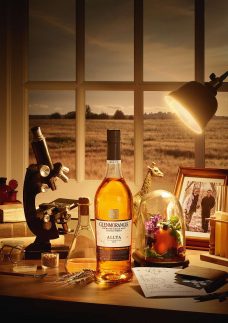 the wild yeast discovered growing on its own barley. It’s at 51.2% abv and has been aged in former bourbon barrels, some of them second fill. Priced around £79 per bottle.
the wild yeast discovered growing on its own barley. It’s at 51.2% abv and has been aged in former bourbon barrels, some of them second fill. Priced around £79 per bottle.
Inspired by a walk in barley fields near the distillery at Cadboll, Glenmorangie Allta (Scots Gaelic for “wild”) marks ten years of its pioneering Private Edition series, by revealing the importance of yeast to Scotch whisky’s many flavours. Yeast type affects fermentation and flavour so this is a fascinating subject.
 Running along the same lines, I recently saw a headline for an online magazine wondering if barley was to be the new “thing” in finding variation in Scotch Whiskies. The whole concept of barley adding to flavour and character is not so very new. I wrote about it in an advanced whisky course for the people here at The Whisky Ambassador some time ago and they’ve been carefully crafting it into training format. The SWRI has already said more research needs to be done on barley and, of course, there is be a need to check whether soil type and nutrients therein affect things too as per grape vines. A number of distilleries in Scotland, Ireland and the US are already running barley variety and terroir trials. I also covered yeast as a topic for that advanced course and I think it’s going to be available as a course this year. Please contact Sue or Jo via www.thewhiskyambassador.com for details of that one and to see if it’s ready yet.
Running along the same lines, I recently saw a headline for an online magazine wondering if barley was to be the new “thing” in finding variation in Scotch Whiskies. The whole concept of barley adding to flavour and character is not so very new. I wrote about it in an advanced whisky course for the people here at The Whisky Ambassador some time ago and they’ve been carefully crafting it into training format. The SWRI has already said more research needs to be done on barley and, of course, there is be a need to check whether soil type and nutrients therein affect things too as per grape vines. A number of distilleries in Scotland, Ireland and the US are already running barley variety and terroir trials. I also covered yeast as a topic for that advanced course and I think it’s going to be available as a course this year. Please contact Sue or Jo via www.thewhiskyambassador.com for details of that one and to see if it’s ready yet.
I’ve mentioned Raasay a few times in recent months and they’ve popped up again with the launch of their 30 litre casks available via their website and at the distillery. The oak is from ex-Speyside casks. Distillery Co-founder Alasdair Day said, “We wanted to make our first single malt more accessible in these new smaller casks. Depending on the angels’ share, after three years we expect to get around 40 bottles from the 30 litre casks, each offering a distinctly different character of Raasay whisky from our other bottlings.”
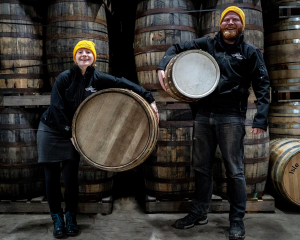
“The 30L casks are small enough to make a present for a loved one or for a special event. Bars or hotels can opt to co-brand their cask and display it on the bar. While the whisky matures, cask owners can come and visit (and lovingly touch!) their cask, staying in Raasay Distillery’s four-star accommodation at Borodale House. After the whisky is bottled, owners can also keep their empty cask as a memento.” Not many places offer cask purchase these days, not to mention handy-sized ones like this so a good one to go for.
The other Raasay offering comes in the shape of pre-orders for the first ever bottles of Isle of Raasay Single Malt. They will be shipped and delivered in time for Christmas 2020. After a fantastic response from members of Raasay Distillery’s free to join Slainte Club, the inaugural release is now publicly available to pre-order on the distillery’s website for £99. Produced and distilled on the Isle of Raasay using only Scottish barley, distillers’ yeast and water from the distillery’s own well there is a fermentation period of up to 115 hours, “bringing a rich, characterful flavour to this island malt spirit before it even touches the oak of the cask”. This first release of Raasay spirit has matured in first fill bourbon barrels at the distillery warehouse since 2017 and in its final year, it will be finished in Bordeaux red wine casks before being bottled at 46% ABV, non-chill filtered and naturally coloured.
And finally, yes, this has been a long one but lots of things to cover, Loch Lomond Group has now launched into the UK domestic market, the Littlemill 40 Year Old 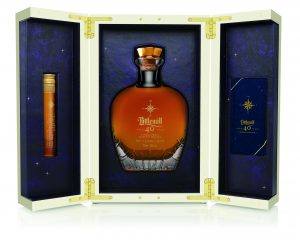 Celestial Edition (46.8% ABV), the oldest expression ever to be released from the now lost (in a fire in 2004) Littlemill distillery. It’s available now priced at £6,000. Only 250 bottles were produced in total.
Celestial Edition (46.8% ABV), the oldest expression ever to be released from the now lost (in a fire in 2004) Littlemill distillery. It’s available now priced at £6,000. Only 250 bottles were produced in total.
Littlemill 40 Year Old Celestial Edition celebrates the life’s work of Littlemill’s former owner, Duncan Thomas. One of his more lasting legacies was the introduction of the straight necked pot still with rectifying heads, that made it possible to create variations on each spirit he produced, allowing him to retain control of the character of the final liquid. This philosophy was embraced by Japanese distilleries.
The presentation box captures an exact map of the night sky seen above Littlemill Distillery on the evening that the liquid was filled into cask. Inside, the hand-faceted Glencairn Crystal decanter, each engraved with its unique bottle number, is finished with a solid brass stopper made in Glasgow. Each box also contains a 5cl vial of the 40 Year Old liquid, for those who would like to sample the whisky while keeping the bottle intact. One for the world’s most expensive whisky bars, methinks. Littlemill’s rich history includes a number of owners over its lifetime and it was notably one of the first distilleries to have a female licensee, Jane MacGregor, in 1823. So the Champagne widows didn’t have a monopoly on 19th century girl power, then.
Till March, then, when it will officially be spring – and the weather will probably be worse. Therefore, enjoy a dram either way!
Caroline
Comments